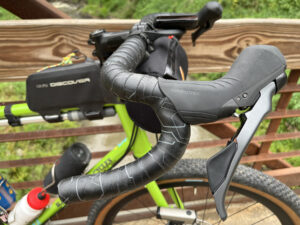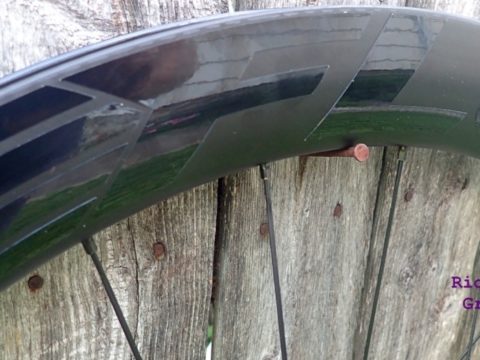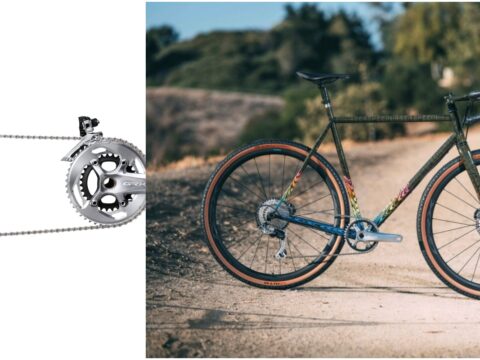
I’ve been riding the new 12-speed Shimano GRX groupset for a few months now, so I have a good feel for how it performs in real world riding conditions. In fact, my GRX-equipped Black Mountain Cycles Mod Zero has seen a wide range of gravel, singletrack and adventure riding, and it’s performed extremely well in all of it.
Be sure to check out my Getting Rolling post to see the specifics of how I built the bike.
A Lasting Good Impression
Much like its 11-speed predecessor, Shimano’s 12-speed GRX groupset delivers an overall excellent user experience. It makes a compelling case for the value of high-end mechanical drivetrains. The shifting is superb and quite frankly, it’s nice to not have to worry about batteries or charging. I can just enjoy riding my bike, and for me, that’s what it’s all about.
With Shimano’s Hyperglide + cassettes, the shifting of the new GRX groupset is as good as it gets for a mechanical drivetrain. It’s easy to shift up or down the cassette under power, and the wider range of the 12-speed 10-45t cassette gives me just enough gear range for the local gravel and trails I ride.
Shimano’s WH-RX880 carbon wheels, while not carrying the GRX name anymore, are a perfect fit for the new GRX group. The 25mm internal rims are a great width for tires up to 55c or so, and so far they haven’t required truing or adjustments of any kind. The bearings are notably very smooth as well.
One thing I failed to mention in my Getting Rolling post is that the RX880 wheels use traditional J-bend spokes rather than the straight-pull spokes of the previous generation wheels. I have to believe this was done to give the new wheels a more compliant ride, but I could be wrong. Either way, the RX880 wheels are a great riding set of wheels. Plus, the new Direct Engagement rear hub feels like a huge step forward for Shimano. It’s relatively silent, but has a very positive engagement feel.
Serious Stoppers
The updated GRX disc brakes have eliminated the rotor/pad rubbing I’d occasionally experience with the older GRX brakes, however their performance is a bit of a mixed bag. I prefer the bite point to be fairly close to the handlebar, and while the new GRX has both reach and bite point adjustment capabilities, I’ve found that even with the reach at its minimum and the bite point adjuster dialed out, I couldn’t get the bite point to engage as close to the bar as I’d prefer.
This wasn’t an issue for me with the previous generation of GRX brakes, nor is it an issue on the Shimano disc brakes I have on other bikes. I’ve tried bleeding the brakes to help move the bite point back, to no avail. Perhaps as the pads wear, the bite point will move back. I hope so, because I love the power and modulation of the new GRX brakes.
One thing I’ve also noticed is that the ‘grippy’ finish on the brake/shift levers seems more durable than it’s been on either of my 11-speed GRX bikes. I’m not sure if Shimano changed the material, or I’ve simply been luckier to not scratch them, but you can’t even tell my 12-speed levers have been ridden. They look brand new.
Dialed Durability
The new GRX groupset has proven to be rock solid in terms of reliability and durability. The chain is still well within spec and there’s no undue signs of wear to the cassette, chainring or brake pads. The crank, while unchanged from the previous generation, is still as stiff and solid as ever, and the finish has proven durable so far.
This is all typical of modern Shimano groupsets, and it’s exactly the type of performance I want on a bike I frequently ride into unpopulated territory.
The Bottom Line

Shimano didn’t rewrite the book with 12-speed GRX… It didn’t need to. First-generation GRX was, and continues to be a fantastic group. That said, Shimano did a great job of taking its proven 12-speed architecture and applying it to the new GRX group. The shifting is next-level good… as good as it gets for mechanical drivetrains, and it’s more than good enough for me.
While I am still working to find my preferred brake setup, most riders will undoubtedly be just fine with the bite point of the new brakes. And from a performance standpoint (power and modulation), they’re very good.
All in all, the new Shimano GRX groupset sets a new benchmark for mechanical drivetrain performance. It proves that electronic drivetrains really are more of a luxury than a necessity. Because from a functionality standpoint, it’s all there. Great work, Shimano!
Goodbye for now…
Now, on a more serious note… This will likely be my final post on Riding Gravel. Guitar Ted has already moved on, and unless something dramatic happens, this will be my final writing for the site. I want to thank each of you for the time you’ve spent reading and reacting to my writing over the past decade or so. It’s been a privilege to share my experiences and I hope that something materializes that will allow me to continue my bicycle-related writing. I’m hopeful that this isn’t goodbye, it’s more of a ‘until we meet again.’ Cheers, friends.
Shimano sent the GRX 12-speed groupset to Riding Gravel for review and testing at no charge. I am not being paid nor bribed for my reviews, and the views expressed are solely my own. Thanks for reading!












Thanks @Tarhib! I appreciate your comment. The new GRX 12-speed group is everything you could want from a mechanical drivetrain. For those who choose to eschew electronics, it’s as good as it gets.